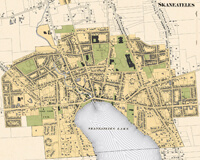Graduate Studio Masterplan Proposals for the Improvement of Bath's Historic Architecture and Urban Fabric

Since the summer of 2009, teams of students from the School of Architecture of the University of Notre Dame in Indiana have visited the City of Bath to study its architecture and urbanism, and have produced masterplan suggestions for areas within the historic city that are either poorly developed or slated for future development. A number of these academic exercises were presented in public venues in Bath and reviewed by members of the City Council, the Bath Heritage Trust, and other officials, and have served as valuable points of departure for discussions regarding future planning improvements that might be implemented by the City. Led by Prof. Richard Economakis, the School’s current Director of Graduate Studies in Architecture and Urbanism, the teams have examined a breadth of issues ranging from the development of the city’s urban fabric since Roman times, the evolution of building types, the adaptation of Palladian and other Renaissance architectural principles in the work of 18th and 19th century architects in Bath, and urban expansion in the Early Industrial and post-War periods.
Notre Dame’s focus on Bath reflects its appreciation of the historic city’s extraordinary state of preservation and its exemplary buildings and public spaces, which exhibit an admirable sense of scale, coordination, consistency of expressions, and quality in design. Bath also exemplifies Georgian attitudes toward the making of buildings and cities that influenced early American architecture and planning, and which now again constitute the basis for development in principles espoused by proponents of the New Urbanism and new traditional architecture. Notre Dame has raised awareness of the architecture of Bath among professionals in these circles and on a national level by showcasing the student work in conferences and exhibitions held around the United States. The 2009 masterplan proposal for the Western Riverside Quarter received an Academic Award of Merit from the Congress for the New Urbanism (2010), and subsequent plans for the Green Park Station and Kingsmead Square area (2011) and Manvers Street neighborhood (2013) have been published and exhibited in Europe and the United States.
In 2015 a new team of graduate students working under Prof. Economakis focused on the Narrow Quay, an area to the west of Churchill Bridge between Ambury Street and the Kingsmead Flats that is now occupied by on-grade parking and parking structures. The proposed masterplan envisages the displacement of the parking to an area to the north-west and the creation of a number of residential blocks with a network of public spaces centering around a three-sided square that opens onto the River Avon. It is envisaged that the western half of the site will be occupied by a new Museum of Science and Industry, fronting Corn Street to the north and looking south across the river to the row of Early Industrial period buildings that line the Lower Bristol Road. The masterplan also establishes a connection north to Kingsmead Square.
In 2014, as part of his graduate studies at the University of Notre Dame, Dr. Christopher Miller, Professor at Judson University, Illinois, produced a masterplan for Lower Walcot Street, north of Pulteney Bridge. The proposed new development hinges on the creation of a new Market Building and eventual replacement of the existing Hilton Bath City Hotel with mixed use urban blocks on the traditional model, which increase the number of hotel rooms while re-establishing the scale and character of the city to the north of Pulteney Bridge.
The Notre Dame masterplan proposals have been presented at the Bath Royal Literary and Scientific Institute, the Bath Society Hall, the Salvation Army Chapel, and a number of other venues in Bath.